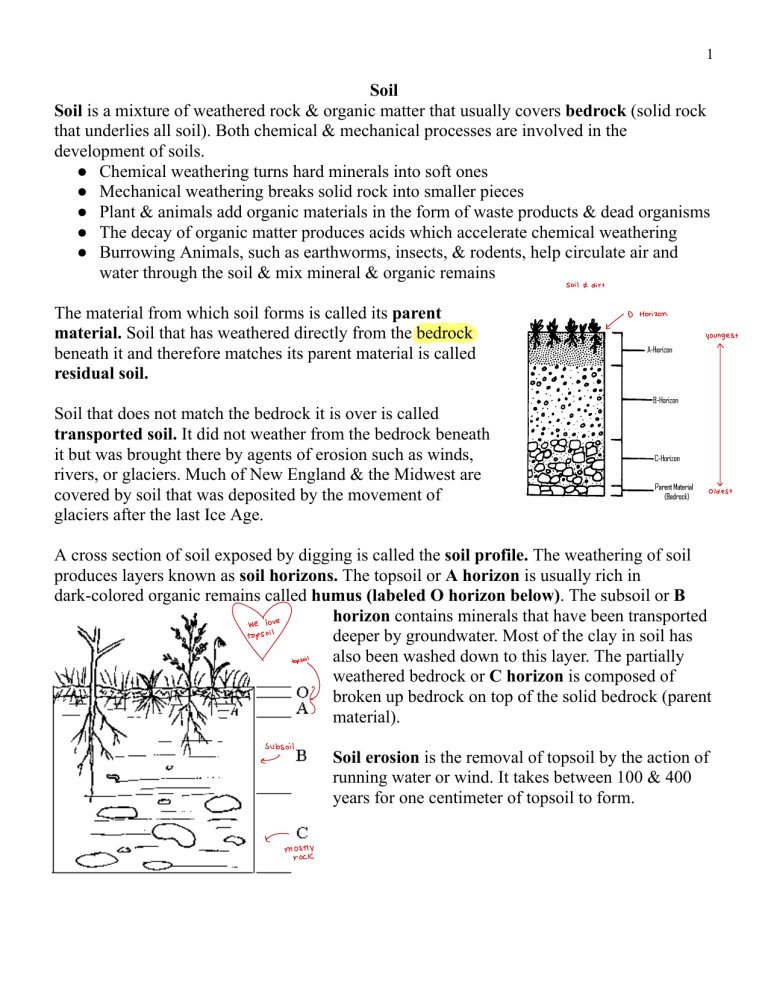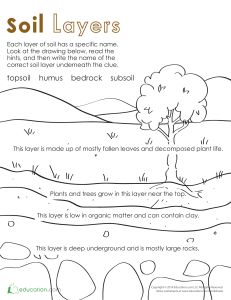
1 Soil Soil is a mixture of weathered rock & organic matter that usually covers bedrock (solid rock that underlies all soil). Both chemical & mechanical processes are involved in the development of soils. ● Chemical weathering turns hard minerals into soft ones ● Mechanical weathering breaks solid rock into smaller pieces ● Plant & animals add organic materials in the form of waste products & dead organisms ● The decay of organic matter produces acids which accelerate chemical weathering ● Burrowing Animals, such as earthworms, insects, & rodents, help circulate air and water through the soil & mix mineral & organic remains Soil The material from which soil forms is called its parent material. Soil that has weathered directly from the bedrock beneath it and therefore matches its parent material is called residual soil. Soil that does not match the bedrock it is over is called transported soil. It did not weather from the bedrock beneath it but was brought there by agents of erosion such as winds, rivers, or glaciers. Much of New England & the Midwest are covered by soil that was deposited by the movement of glaciers after the last Ice Age. dirt ~ D Horizon youngest 1 oldest A cross section of soil exposed by digging is called the soil profile. The weathering of soil produces layers known as soil horizons. The topsoil or A horizon is usually rich in dark-colored organic remains called humus (labeled O horizon below). The subsoil or B horizon contains minerals that have been transported deeper by groundwater. Most of the clay in soil has also been washed down to this layer. The partially weathered bedrock or C horizon is composed of broken up bedrock on top of the solid bedrock (parent material). · ~ mosik Soil erosion is the removal of topsoil by the action of running water or wind. It takes between 100 & 400 years for one centimeter of topsoil to form. 2 Loss of topsoil can be caused when plants root are no longer present to hold down soil. Salting roads can raise the salinity of the soil and kill the plants. Over grazing can kill plants. Winds, construction, & mining can all effect plant cover. - : e e S - issue - Means of soil conservation include the following: ● Windbreaks – belts of trees along the edge of fields ● Contour farming – crops are planted in rows parallel to land contours p143 ● Terraces- flattening hill slopes to slow the flow of water & erosion ● Strip Cropping – a crop that leaves bare ground between rows is alternated with a crop that completely covers the ground, ex. Corn & Alfalfa ● No-till method- plowing, planting and fertilizing are all done at the same time so there is less chance of wind removing topsoil Use the worksheet above to answer the following questions. _____ 1. Which layer in the diagram below contains the most organic material? A. A B.B C.C D. the bedrock A - _____ 2. How is soil created from rock? O physical weathering with chemical weathering A. B. chemical weathering without physical weathering C. erosion without weathering D. weathering without erosion A _____ 3. What causes soil erosion? d A. Wind C. Human activity B. Water D. All of the above _____ 4. Approximately how many years does one centimeter of topsoil take to form? A. 100 – 400 years C. 1000 – 4000 years B. 10 – 40 years D. 10,000 – 40,000 years A - _____ 5. Which of the following is found in the greatest % in soil? A. Mineral matter B. Organic matter C. Water D. Air ____ 6. Which layer of a soil profile forms first from the bedrock? A. A horizon B. B horizon C. C horizon D. humus C - 3 7. For the soil profiles below, label the horizons (A, B, or C) and the parent material in each of the soil profiles using the spaces provided next to each image. A A youngest topsoil B C C C parent Bedrock pm material (pm) - ______ ______ I 3 ______ 2 8. At the base of each profile above, number the profiles according to the proper sequence of development. 9. Match each soil profile above to the graph below that would most likely represent that profile. Write the letter of the matching profile in the space provided below each graph. B C A 4 THE SOIL TEXTURAL TRIANGLE - Soil Textural Triangle Practice Exercises % Sand % Silt % Clay Texture Name a) 75 10 15 _______________________ Loamy Sand b) 10 83 7 _______________________ Silt 5 Soil Texture Worksheet Directions: Using your soil texture chart and example, determine the following soil textures using the percentages given. % sand % silt % clay 75 10 15 sandy loam a) b) 42 ______ 38 _____ 52 37 21 _________________ clay __________________ c) ______ 25 35 50 Clay d) 64 30 ______ 16 __________________ loam sandy e) 50 ____ 18 40 __________________ sandy clay example 20 Soil Texture 10 am loam __________________ Now for a challenge!: f) 36 ______ 35 38 ______ Clay Loam g) _____ 12 ______ 53 42 h) 82 _____ S ______ 10 ______ Loamy sand i) _____ 36 ______ 60 _____ 18 silt loam Silty Clay Use the internet to answer the following question: Discuss the negative effects of soil erosion. List and define 3 types of soil erosion. Soil Erosion can lead to less fertile land for plants, more pollution in waterways, and increase of natural disasters 3 Types of Soil Erosion 1. Sheet Erosion - Thin layer of soil gets removed by runoff water 2. Rill Erosion - Streams of running water dig small channels in the soil 3. Gully Erosion - Water runs through land and creates large ditches or gullies 6 Define the following terms: porosity Space between soil particles where water and air are permeability How easily water can move through spaces in soil infiltration Water on the ground gets absorbed into the soil desertification Fertile land turns into desert because of drought, deforestation or improper agriculture salinization Too much salt in the soil, can damage the crops waterlogging Giving plants too much water, can suffocate the roots of plants

